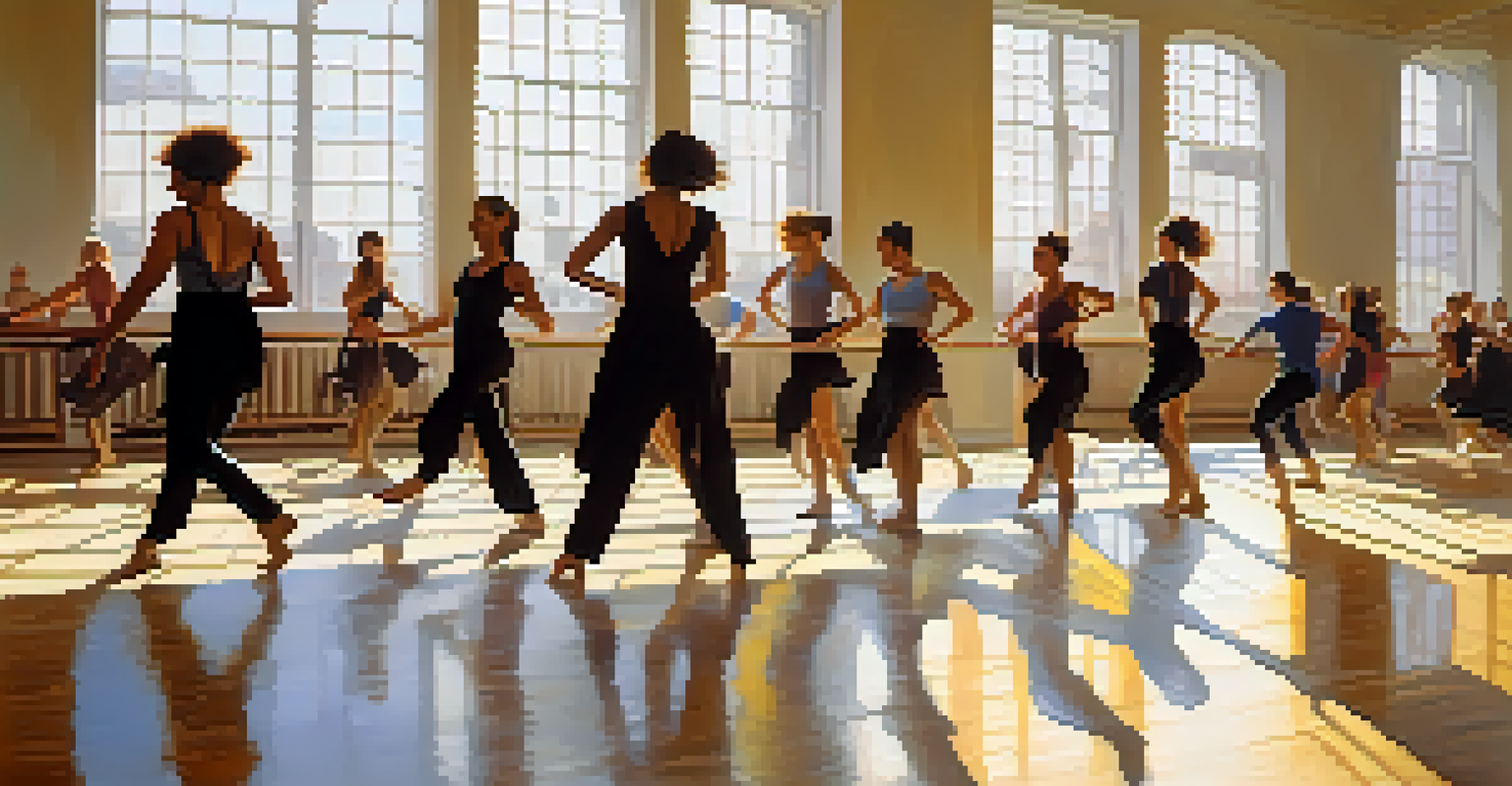The Future of Dance Funding: Trends in Public Policy

Understanding the Current Landscape of Dance Funding
Dance funding today is a complex tapestry woven from various sources, including private donations, grants, and government support. Artists and organizations often rely on a mix of these funds to sustain their work. However, as public interest in the arts fluctuates, so does the financial landscape, leading to unpredictable funding cycles. This creates a challenge for dance companies trying to maintain stability while also pursuing innovative projects.
Dance is the hidden language of the soul.
In recent years, we've seen a shift where public policy plays a larger role in funding decisions. Governments are increasingly recognizing the cultural and economic value of the arts, leading to initiatives aimed at boosting funding for dance and other performing arts. However, navigating these policies can be daunting for organizations that may not have the resources to stay updated on changes. Understanding how these policies work is vital for securing financial support.
Moreover, the push for diversity and inclusion in funding means that more organizations are being encouraged to reach underserved communities. This not only broadens participation in the arts but also reflects a growing recognition that dance is an essential part of cultural expression. As we look forward, understanding the intricate connection between public policy and dance funding will become ever more crucial.
Emerging Trends in Public Policy Affecting Dance Funding
Recent years have seen a trend towards more equitable funding distributions, aiming to support a broader range of dance forms and communities. This shift often emphasizes the need for transparency in how funds are allocated, allowing smaller and underrepresented groups to gain access to resources that were previously out of reach. Such policies challenge traditional funding structures that have historically favored larger, established organizations.

Additionally, there has been a rise in public-private partnerships that provide new avenues for funding. These collaborations can bring together government resources with the innovative ideas of private organizations, creating a more dynamic funding ecosystem. By leveraging the strengths of both sectors, we can expect to see more creative approaches to supporting dance projects and initiatives.
Diverse Funding Sources Are Essential
Dance organizations increasingly rely on a mix of private donations, grants, and government support to sustain their work amid fluctuating public interest in the arts.
Furthermore, the increasing recognition of mental health and well-being in the arts is shaping funding policies. As society acknowledges the therapeutic benefits of dance, funding is being directed toward programs that prioritize mental health initiatives. This progressive view fosters an environment where dance can be seen not just as an art form, but as an essential component of community health and resilience.
The Role of Technology in Securing Dance Funding
Technology is revolutionizing how dance organizations approach funding. Online crowdfunding platforms have democratized the fundraising process, allowing artists to connect directly with supporters. This shift empowers creators to take charge of their financial futures, crafting campaigns that resonate with their audience while showcasing the impact of their work.
Art is not a luxury, but a necessity for our well-being.
Social media also plays a crucial role in building community support and raising awareness about funding needs. By sharing stories, performances, and behind-the-scenes glimpses, dance companies can cultivate a dedicated following that is more likely to contribute financially. Engaging content can transform casual followers into passionate advocates who feel connected to the organization’s mission.
Moreover, data analytics tools are helping organizations to track and analyze funding trends more effectively. By understanding what resonates with donors, dance companies can tailor their efforts to align with the interests and values of potential funders. This data-driven approach can lead to more strategic and successful fundraising efforts, setting a foundation for long-term sustainability.
Community Engagement as a Funding Strategy
Involving the community in dance projects is becoming a crucial strategy for securing funding. Engaging local audiences not only enhances the relevance of the art form but also fosters a sense of ownership among community members. When individuals feel a personal connection to a project, they are more likely to support it financially, creating a sustainable funding model.
Community engagement can also take the form of partnerships with local businesses and organizations. By collaborating with entities that share similar goals, dance companies can tap into new funding sources while enriching their programs. These partnerships often lead to innovative projects that resonate with the community, further strengthening the case for financial support.
Community Engagement Drives Support
Involving local audiences and forming partnerships with businesses are key strategies that enhance funding opportunities and foster a sense of ownership in dance projects.
Moreover, initiatives that focus on community well-being often attract attention from public funding sources. Policymakers are increasingly interested in projects that demonstrate a positive impact on local communities, which can open doors for grants and sponsorships. As the narrative surrounding dance evolves, aligning projects with community needs can significantly enhance funding opportunities.
The Impact of Global Events on Dance Funding Policies
Global events, such as the COVID-19 pandemic, have had a profound effect on dance funding policies. The crisis forced many organizations to adapt quickly, seeking new ways to engage audiences and secure financial support. As a result, governments and funding bodies began to recognize the need for flexible funding mechanisms that could respond to unforeseen challenges faced by the arts sector.
In the wake of such events, we are witnessing a shift towards more resilient funding models that can withstand future disruptions. This includes multi-year funding commitments and emergency grants designed to support artists during crises. Such policies not only provide immediate relief but also encourage long-term planning and stability within the dance community.
Additionally, global events have sparked conversations about sustainability and the role of the arts in recovery. Policymakers are increasingly looking at how funding for dance can contribute to broader societal goals, such as economic recovery and community resilience. This shift underscores the importance of dance as a vital part of the cultural fabric, deserving of support in times of need.
Navigating Challenges in Dance Funding and Policy
Despite the positive trends in dance funding, challenges remain. Many organizations struggle to keep pace with the changing landscape of public policy, often lacking the resources to adapt their strategies effectively. This gap can lead to missed opportunities for funding and growth, highlighting the need for ongoing education and support within the industry.
Moreover, the competitive nature of grant applications can be daunting, especially for smaller organizations. Standing out among numerous applicants requires not only a compelling proposal but also a strong track record of community impact. This can put additional pressure on organizations that are still building their profiles and seeking recognition.
Technology Transforms Fundraising
Online crowdfunding and social media are revolutionizing how dance companies secure funding, enabling them to connect directly with supporters and tailor their outreach efforts.
Lastly, the volatility of funding sources can be a significant barrier. As public funding fluctuates with political priorities and economic conditions, dance companies must develop strategies for diversifying their revenue streams. This proactive approach can help mitigate the risks associated with reliance on a single funding source, leading to greater stability in the long run.
Looking Ahead: The Future of Dance Funding and Policy
As we look to the future, the landscape of dance funding is likely to continue evolving. The increasing emphasis on equity, community impact, and technological integration will shape how funding is allocated and distributed. Dance organizations that embrace these trends will be better positioned to thrive in an ever-changing environment.
Furthermore, the continued collaboration between the arts sector and public policy will be crucial. Advocates for the arts must work together to ensure that dance remains a priority in funding discussions. By demonstrating the value of dance to society, organizations can help influence policies that support its growth and sustainability.

Ultimately, the future of dance funding hinges on adaptability and innovation. By remaining open to new ideas and approaches, dance companies can navigate the complexities of funding while staying true to their artistic vision. With a focus on community engagement, technology, and resilient funding models, the future looks promising for the dance community.